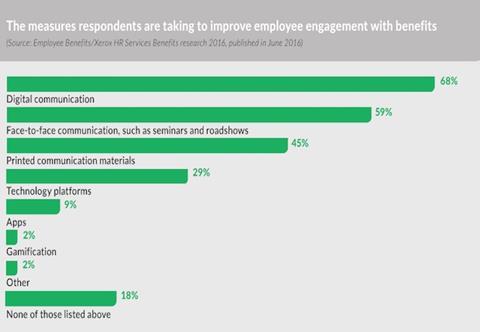
Driving take-up of any employee benefits package is a perennial challenge for employers; after all, it is no good having a comprehensive scheme if people do not know about it, or understand the value they could potentially get.
A good starting point for employers is to make sure they are offering the right benefits in the first place, as well as identifying and addressing any broader issues, says Duncan Brown, head of HR consultancy at the Institute for Employment Studies. He cites the example of a business that had, on the face of it, a strong benefits offering that had seen staff turnover increase from 20% to 30% in a year, with no obvious explanation.
The solution was to run a series of focus groups, to hear directly from staff what they wanted from their employer. “Ultimately, it may only be by chatting with staff that we’re really going to pick that up,” he says.
Listening to staff
Often, the mere fact that the employer is listening to its staff can make a difference, adds Debra Corey, group reward director at Reward Gateway, who recently implemented a number of new benefits following consultation with employees. “It’s less about the benefits, and more that we listened to them,” she says. “Our staff told us they wanted more time, and more wellness, and we put in two new benefits that did that. But I think I’m going to get more return on investment because we did what they said than through the actual benefits themselves. But it’s difficult, because you can’t always do what employees ask you to do.”
Once benefits are in place, it is important to try and encourage people to find out about them and take them up if appropriate. One way of doing this is to nudge people into taking action through gentle reminders and modelling how taking action would affect them. Alan Ritchie, head of trustee and employer proposition at Standard Life, says: “On the pensions side, one of the most important things is to try and get people to reach the pot they need at retirement, and that comes down to how much they pay in.
“We try to nudge people with our save-more-tomorrow scheme, so if they can’t afford to pay now then they can at least sign up to future increases. But we’ve also launched something called ‘maximum matching’, where if someone wants to pay in 2% a warning box will come up on the benefits platform pointing out that the employer will match contributions up to 4%.”
One organisation recently achieved 74% of its population signing up to one or both of these initiatives, proving these can be far more effective than holding face-to-face seminars because they can target much larger populations, adds Ritchie.
There are other techniques that can be deployed too, says Richard Morgan, head of Vebnet. “It’s almost a bit of peer pressure, but you can show people what others like them are doing, particularly if they’re a little bit behind,” he says. “So [saying] ‘did you know that people in your age group are typically paying 5%, and you’re at 2%?’ It’s not quite gamification, but it taps into that competitive element.”
This can raise some difficult issues, though. Charles Cotton, performance and reward adviser at the Chartered Institute of Personnel and Development (CIPD), warns there could be a risk that people will give up on saving altogether if they feel what they do put away is inadequate.
Corey also has reservations. “You want people to make decisions for the right reasons,” she says. “I always get a bit confused about where my role begins and ends when it comes to those things. For me, it’s about education and then letting them decide.”
Where it can work well is through the visual representations of just what impact increasing contributions could have. “We were doing this 15 years ago when I was in Gap in the US,” says Corey. “It was a bar graph that said ‘you’re contributing 3% now and this is what it looks like; if you had contributed 5% this is what it would look like’. We had a number of people who went up one spot on the bar graph.”
The experience of auto-enrolment also provides evidence of just how powerful pointing people in the right direction can be, says Ritchie. “It’s a great example of nudging people towards being in, because you have to opt out,” he says. “Opt-out rates are around 6% at the moment so really low, and hopefully that means people are getting a much better future as a result.”
Nudging people will have a role to play when minimum contribution levels increase in 2018 and 2019, to stave off an increase in people opting out at that point, he adds.
Increasing financial awareness
Financial awareness in general is one area where employees need help, says Brown. “There’s probably a minority of people who are financially skilled, and the majority aren’t,” he says. “It’s a questions of what the employer’s responsibility is here, so does it help and how far [should it] push?”
Regulatory bodies have moved towards putting more responsibility on employers here in recent years.
The problem is that the constantly changing landscape around personal finances, including the introduction of the lifetime individual saving account (Isa), also makes it hard for employees and employers to stay on top of this. “The lifetime Isa is a good thing but potentially very confusing and people could make the wrong choices by not having the right level of education around it,” says Morgan. “So is someone better off putting their money into that or into a pension scheme? It all depends on what they want to use the money for; quite possibly they’d be much better putting it in the pension scheme, but it depends on individual circumstances.”
The situation is made even more complicated by having multiple generations in the workplace, says Corey. “You have to segment it, and then get your head around the changes and what you’re going to do about it,” she says. “More [organisations] are bringing in people to help from the financial awareness perspective; 10 years ago I could never have got budget approval to bring somebody in but now, more and more, I can get my boards to do that.”
Any support needs to be well targeted, depending on people’s age and stage in life, says Ritchie. “There’s no point in talking to somebody who’s 50 about a lifetime Isa, and equally there’s no point in talking to somebody with £20,000 in their pot about a lifetime allowance,” he says. “The targeting of the education is vital to get people to take notice and do the right thing, and take-up rates should go up as a result of that.”
Effective communication is vital
Effective communication is also essential. The key here is to segment messages to target particular groups, which can help maximise the impact, says Ritchie. “We did some seminars around annual and lifetime allowances, where we worked with employers to only target those people who were close to being impacted by those limits, ahead of the changes that were coming in in April,” he says. “There was one [organisation] that had 68% take-up, but that’s because it was 68% of people who were very interested. If we’d just contacted everybody, that percentage would have been much lower.”
Such sessions can be a cost-effective alternative to more expensive financial education programmes.
Inevitably, interest and take-up will both be higher when it is an issue that resonates with employees, or groups of employees, says Corey. One such example would be a business with a young workforce where staff were about to receive a windfall payment as a result of a share scheme payout.
“[This organisation] brought in financial advisors, and had huge take-up of people attending these sessions, because they could very clearly see what was in it for them,” she says. “But that’s the challenge; trying to segment it so that you can see why you should actually go to that website and start doing the gamification and everything else. It can be very difficult to get employees to do that.”
One solution could be to host any resources on a benefits platform and tie it into an annual renewal window when people are more likely to be using the site anyway.
User-friendly products
Providers have also made efforts in recent years to make their products more user-friendly, encouraging employees to use them, says Morgan. This could be by removing the need to remember user names and passwords, but also giving employees a more consumer-style experience when they do go on sites. “A lot has been learned from other sectors and platforms such as Amazon, and employers and technology providers have learned from looking at what’s happened outside their own little world. It’s about making it easier and more fun for employees rather than just handing over information. But you’ve got to give people an incentive to go in as well.”
Employers can also make a real difference to take-up by helping to promote the messages that come through from providers. “Something that came through recently for us, which should have been obvious, was the power of the employer endorsement in that situation,” says Ritchie. “We tried something where we sent out an email to a particular population on a particular topic, and we got a certain take-up rate.
“Then we tried it again where the employer sent out something first, saying ‘you’re about to hear from Standard Life and we encourage you to read it’. The take-up rate for the second group was much higher. The fact that [it was] sending something out in advance made it much more effective and it was only by trying it out that we realised it. It’s become part of how we do things now.”
Corey has also used this tactic, even going as far as to create a caricature of herself that she uses when she needs to send out important information. “In my last [organisation], I ran focus groups and told them that every time they see that little cartoon character it means it’s something that they actually want to open,” she says. “But it is difficult getting people’s attention.”
A further issue for reward professionals, though, is finding enough time to put in place such initiatives, at a point where there are a large number of other projects and regulatory changes taking place. “As a reward person, it’s just trying to do things when you keep getting things thrown at you,” says Corey. “It would be nice to know that in two years from now the government won’t throw us the national living wage or pensions auto-enrolment so we can start doing some exciting things. It feels as if I’ve been playing dodgeball over the last few years.”




































